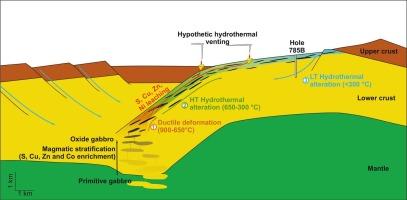Sulfur and metal mobilization during the life cycle of an oceanic core complex: Implications for seafloor massive sulfide deposits formation at slow and ultra-slow spreading ridges
IF 2.9
2区 地球科学
Q2 GEOCHEMISTRY & GEOPHYSICS
引用次数: 0
Abstract
Seafloor massive sulfide (SMS) deposits at slow and ultra-slow spreading ridges are often spatially related to, or hosted in oceanic core complexes (OCCs). The specific oceanic crust architecture, magmatism, hydrothermal fluid circulation and lithologies at OCCs, however, imply different S and metal (e.g. Cu, Zn, Co, Ni) fluxes relative to well-structured oceanic crust at-fast spreading ridges and which are not yet fully constrained. The study of S and metal distribution in the ODP Hole 735B deep drill core from the Atlantis bank allows to understand these fluxes along detachment faults and to better constrain the source zone of S and metals for OCC-related SMS deposits. Significant depletion of S, Cu, Zn and Ni are observed within the upper 250 m of the drill core where intense deformation and hydrothermal fluid circulation occurred. During the complex tectono-magmatic-hydrothermal evolution of the Atlantis Bank, four important stages are recognized for S and metal mobilization: 1) magmatic stratification leading to a higher proportion of sulfide-rich and S, Cu, Zn and Co fertile oxide gabbros in the root zone of the Atlantis Bank detachment, 2) high temperature ductile deformation leading to magmatic sulfide reworking and onset of sulfide leaching with limited metal mobilization, 3) extensive sulfide leaching and metal mobilization during amphibolite to greenschist facies metasomatism and, 4) late stage secondary sulfide precipitation and S enrichment during low temperature fluid circulation. Mass balance calculations from the source zones of the Atlantis Bank detachment highlights that metal mobilization during hydrothermal alteration of gabbroic rocks along detachment faults can fully account for the formation of OCC-related SMS deposits at slow and ultraslow spreading ridges. The Atlantis Bank detachment system, however, is gabbroic-dominated and represent the magmatic end-member of OCCs and further work is necessary for understanding metal fluxes in ultramafic-dominated detachment systems.

大洋核心复合体生命周期中的硫和金属动员:对慢速和超慢速扩张海脊海底块状硫化物矿床形成的影响
慢扩张海脊和超慢扩张海脊的海底块状硫化物(SMS)矿床通常与大洋核心复合体(OCCs)在空间上相关,或位于大洋核心复合体中。然而,大洋核心复合体的特定大洋地壳结构、岩浆活动、热液循环和岩性,意味着与快速扩张海脊上结构良好的大洋地壳相比,具有不同的S和金属(如铜、锌、钴、镍)通量,而这些通量尚未得到充分制约。通过对亚特兰蒂斯岩滩 ODP 735B 号钻孔深部岩芯中的锰和金属分布的研究,可以了解沿脱落断层的锰和金属通量,更好地确定与 OCC 有关的 SMS 沉积的锰和金属源区。在钻探岩芯上部 250 米处观察到了 S、Cu、Zn 和 Ni 的严重损耗,这里发生了强烈的变形和热液循环。在亚特兰蒂斯岩滩复杂的构造-岩浆-热液演化过程中,S 和金属的移动分为四个重要阶段:1)岩浆分层导致亚特兰蒂斯岩滩脱离体根部区域富含硫化物和 S、Cu、Zn 和 Co 的肥沃氧化辉长岩比例增加;2)高温韧性变形导致岩浆硫化物再加工和硫化物浸出的开始,但金属移动有限;3)广泛的硫化物浸出和热液循环导致亚特兰蒂斯岩滩脱离体根部区域富含硫化物和 S、Cu、Zn 和 Co 的肥沃氧化辉长岩比例增加、3) 在闪长岩向绿泥石岩相变质过程中,硫化物广泛沥滤并动员金属;以及 4) 在低温流体循环过程中,晚期次生硫化物沉淀和 S 富集。对亚特兰蒂斯岸剥离源区进行的质量平衡计算表明,沿剥离断层的辉长岩热液蚀变过程中的金属移动完全可以解释慢速和超慢速扩张脊上与 OCC 有关的 SMS 矿床的形成。然而,亚特兰蒂斯岸剥离系统以辉长岩为主,代表了OCC的岩浆末端成分,要了解以超基性岩为主的剥离系统中的金属通量,还需要开展进一步的工作。
本文章由计算机程序翻译,如有差异,请以英文原文为准。
求助全文
约1分钟内获得全文
求助全文
来源期刊

Lithos
地学-地球化学与地球物理
CiteScore
6.80
自引率
11.40%
发文量
286
审稿时长
3.5 months
期刊介绍:
Lithos publishes original research papers on the petrology, geochemistry and petrogenesis of igneous and metamorphic rocks. Papers on mineralogy/mineral physics related to petrology and petrogenetic problems are also welcomed.
 求助内容:
求助内容: 应助结果提醒方式:
应助结果提醒方式:


